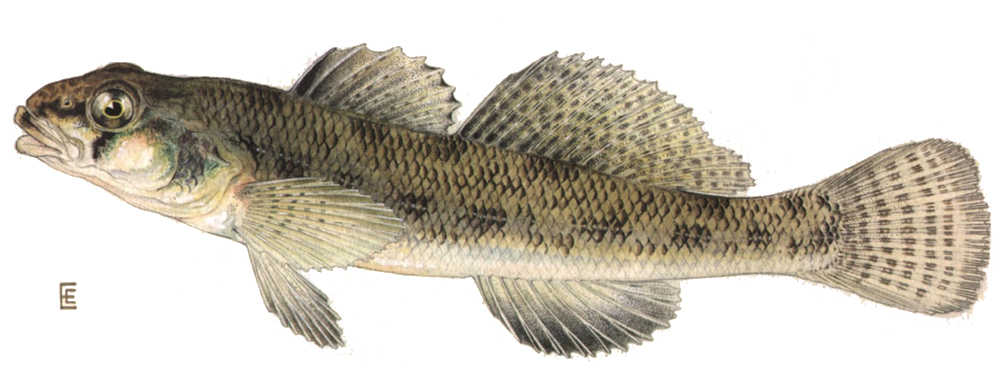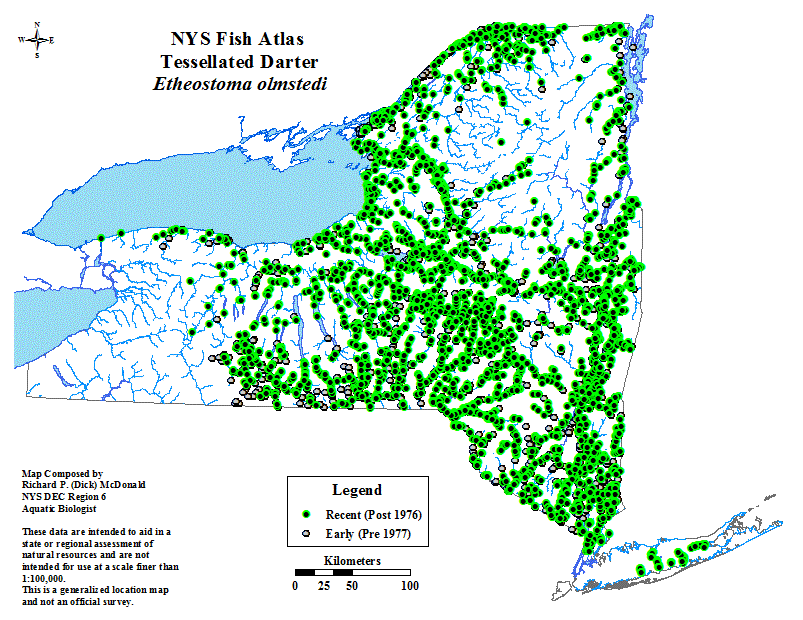
Tessellated Darter (Etheostoma olmstedi)
Three forms of the tessellated darter have been found in the Hudson-Mohawk system . In the main Hudson below Troy, the species is characterized by having the nape, cheek, opercle, breast, and belly usually fully scaled. This form also occurs in the Lower Delaware and in the streams of the Chesapeake Bay drainage between the fall line and weakly brackish waters. Tthese specimens are assigned to the subspecies Etheostoma olmstedi atromaculatum. A second form occurs in the Wallkill and in smaller tributary streams that flow directly into the ocean or are headwaters of larger streams from Cape Cod to North Carolina. The latter formis called E. o. olmstedi and it has the nape usually naked, the cheek variously scaled, the breast usually naked, and the belly moderately scaled. In the Upper Hudson and Mohawk, as well as in Lake Ontario, Lake Champlain, the St. Lawrence drainage, Long Island, and the Delaware and Susquehanna tributaries, the fish are intermediate and these are recognized as intergrades.
This pattern suggests that the coastal fish became isolated during the Pleistocene and differentiated. With the retreat of the glaciers, the area that is now central New York was reinvaded from the south through the Susquehanna and Delaware Rivers and from the east through the Hudson. The overall range of the tessellated darter is from the St. Lawrence drainage in southern Quebec, the southern tributaries of Lake Ontario, the Connecticut River and coastal streams from Massachusetts to the Altamaha River in Georgia. It also occurs as a disjunct population in the Oklawaha River in Florida.
The tessellated darter occurs in both flowing and standing waters but it shows a preference for quieter areas and, except during the breeding season, for sand or mud bottoms.
Tthe nesting and spawning of tessellated darters was described in the New York Aquarium, 24 May through 9 June 1939. The fish, which originally came from northern New Jersey, laid their adhesive eggs on the underside of an unusually large mussel shell that was lying with the concave side upward. The spawning pair turned upside down and the female vibrated as she deposited the eggs, which were then fertilized by the male as he moved slowly over them. Usually, the partners assumed a side-by- side position either head to tail or head to head but there was no clasping or mounting, although the male's body sometimes crossed that of the female.
Spawning was frequently interrupted by the approach of another fish as the male broke away to give chase to the stranger. Spawning appeared to be triggered by one partner turning over; most often it was the male. After spawning, the female abandoned the nest and the male remained to guard and aerate the eggs either by fanning the water with his tail while holding his position under the eggs with his pectoral fins, or by swimming upside down over the eggs and brushing them with his pectorals. Hatching took place after about 21 days at 65 F. Usually, only one male will nest under a single stone but as many as three have been noticed using the same stone where nesting sites were scarce. Sometimes the eggs were laid on the top and sides of rocks in crowded conditions.
The diet of the tessellated darter is assumed to be similar to that of the johnny darter, dominated by entomostracans and small insects while the fish are small, gradually shifting to larger insects as the fish get bigger.
Distribution of the tessellated darter in NY state.
An image of the tessellated darter is also available for download.
The above species description was taken out of "The Inland Fishes of New York State" by C. Lavett Smith, published by the New York State Department of Environmental Conservation, 1985.
